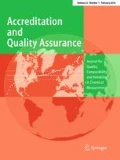Abstract
Measurement uncertainty is of high importance to all testing and calibration laboratories and those involved in sampling activities. Its evaluation requires good understanding of the method implemented and realisation of all factors contributing to it. It is required that the users of the results fully understand the meaning of uncertainty stated on test reports and calibration certificates and, when needed, ask for clarifications. Laboratories, both the accredited ones and those being prepared towards their accreditation, need to take this into account when evaluating the uncertainty of their results. Competent authorities need to consider the stated uncertainty to compare the result with a legislative limit. The producer can decide on adjustments needed. The consumer may find it more difficult to understand how this “uncertain component” of the results could affect their health, safety or economic rights. This article describes the relevant requirements of the accreditation standards referring both to testing and calibration laboratories and to proficiency testing and reference material producers. Further to this, the article explains why all these factors have to be considered by a laboratory.


Change history
30 May 2018
Unfortunately, the references 12 and 13 were incorrectly published in the original publication. The correct references are:
References
ISO/IEC 17025 (2017) General requirements for the competence of testing and calibration laboratories. International Organization for Standardization/International Electrotechnical Committee, Geneva
ISO 15189 (2012) Medical laboratories—requirements for quality and competence. International Organization for Standardization, Geneva
ISO 17034 (2016) General requirements for the competence of reference material producers. International Organization for Standardization, Geneva
ISO/IEC 17043 (2010) Conformity assessment—General requirements for proficiency testing. International Organization for Standardization/International Electrotechnical Committee, Geneva
Barwick V (ed) (2016) Eurachem/CITAC Guide: Guide to quality in analytical chemistry: an aid to accreditation. www.eurachem.org
ISO/IEC 17011 (2017) General requirements for the competence of testing and calibration laboratories. International Organization for Standardization/International Electrotechnical Committee, Geneva
ISO/IEC 17011 (2004) General requirements for the competence of testing and calibration laboratories. International Organization for Standardization/International Electrotechnical Committee, Geneva. Superseded by ISO/IEC 17011 (2017)
Regulation (EC) No 765/2008 of the European Parliament and the Council of 9 July 2008 setting out the requirements for accreditation and market surveillance relating to marketing of products and repealing Regulation (EEC) No 339/93 OJ L 218/30
Eurachem/CITAC (1998) Quality assurance for research and development and non-routine analysis 1998. ISBN: 0 948926 11 2. www.eurachem.org
ISO 21748 (2010) Guide to the use of repeatability, reproducibility and trueness estimates in measurement uncertainty estimation. International Organization for Standardization, Geneva
ISO/TS 19036 (2006) Microbiology of food and animal feeding stuffs—guidelines for the estimation of measurement uncertainty for quantitative determinations. International Organization for Standardization, Geneva
ISO 29201 (2012) Water quality—the variability of test results and the uncertainty of measurement of microbiological enumeration methods. International Organization for Standardization, Geneva
ISO/IEC Guide 98-4 (2012) Uncertainty of measurement—part 4: role of measurement uncertainty in conformity assessment. International Organization for Standardization, Geneva
EA 4-02 M (2013) Measurements in calibration. www.european-accreditation.org
EA 4-16 G 16 (2003) EA guidelines on the expression of uncertainty in quantitative testing. www.european-accreditation.org
ILAC P10 (2013) ILAC policy on traceability of measurement results. International Laboratory Accreditation Cooperation. http://ilac.org/publications-and-resources/ilac-documents
ILAC P14:01 (2013) ILAC Policy for uncertainty in calibration. International Laboratory Accreditation Cooperation. http://ilac.org/publications-and-resources/ilac-documents
ILAC G17 (2002) Introducing the concept of uncertainty of measurement in testing in association with the application of the Standard ISO/IEC 17025. http://ilac.org/publications-and-resources/ilac-documents
Ellison SLR, Williams A (eds) (2012) Eurachem/CITAC guide CG4: quantifying uncertainty in analytical measurement. www.eurachem.org
Silva RJNB, Williams A (eds) (2015) Eurachem/CITAC guide: setting and using target uncertainty in chemical measurement. www.eurachem.org
Ellison SRL, Williams A (eds) (2007) Eurachem/CITAC guide: use of uncertainty information in compliance assessment, 1st edn. www.eurachem.org
Measurement uncertainty revisite.Technical Report 1/2007, Eurolab (2007). www.eurolab.org
Ramsey MH, Ellison SRL (eds) (2007) Eurachem/EUROLAB/CITAC/Nordtest/AMC Guide: measurement uncertainty arising from sampling: a guide to methods and approaches Eurachem. ISBN 978 0 948926 26 6
Joint BIPM, OIML, ILAC and ISO Declaration on Metrological Traceability (2011). http://www.bipm.org/common/pdf/BIPM-OIML-ISO_joint_declaration_2011.pdf
ISO/IEC Guide 99 (2007) International vocabulary of metrology-basic and general concepts and associated terms (VIM3 3rd edn; http://www.bipm.org.vim)
ISO/IEC 17025 (2005) General requirements for the competence of testing and calibration laboratories. International Organization for Standardization/International Electrotechnical Committee, Geneva. Superseded by ISO/IEC 17025 (2017)
ISO Guide 34 (2009) General requirements for the competence of reference material producers. International Organization for Standardization, Geneva
Tsimillis KC (2015) Training needs to understand quality assurance. Accred Qual Assur 20:53–59
Author information
Authors and Affiliations
Corresponding author
Rights and permissions
About this article
Cite this article
Tsimillis, K.C. Measurement uncertainty: requirements set in the accreditation standards. Accred Qual Assur 23, 109–114 (2018). https://doi.org/10.1007/s00769-018-1310-3
Received:
Accepted:
Published:
Issue Date:
DOI: https://doi.org/10.1007/s00769-018-1310-3

